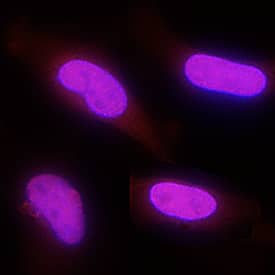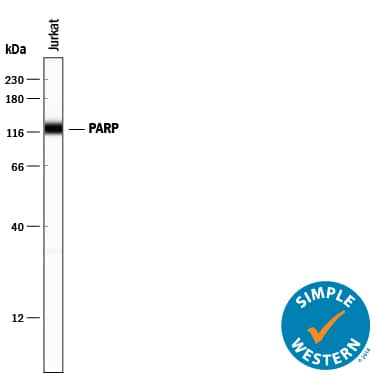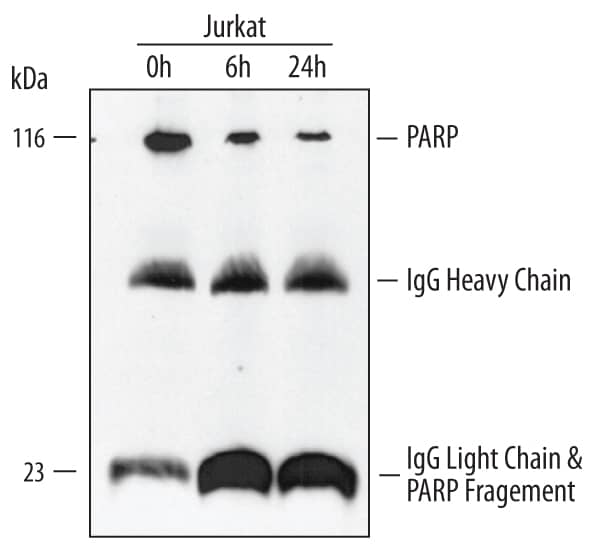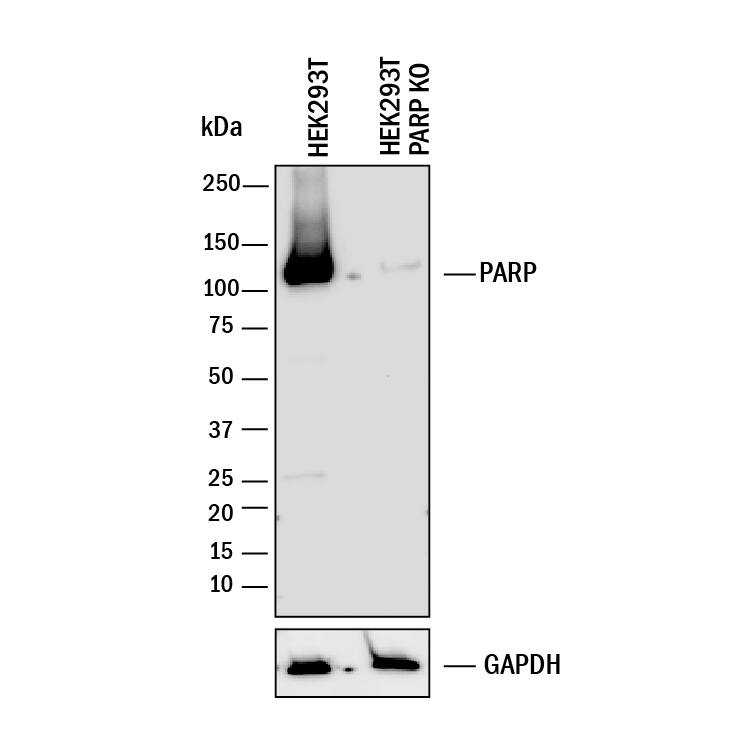Human/Mouse PARP Antibody
R&D Systems, part of Bio-Techne | Catalog # AF-600-NA


Key Product Details
Validated by
Knockout/Knockdown, Biological Validation
Species Reactivity
Validated:
Human, Mouse
Cited:
Human, Mouse
Applications
Validated:
Immunocytochemistry, Immunoprecipitation, Knockout Validated, Simple Western, Western Blot
Cited:
Flow Cytometry, Immunocytochemistry, Proximity Ligation Assay (PLA), Western Blot
Label
Unconjugated
Antibody Source
Polyclonal Goat IgG
Product Specifications
Immunogen
E. coli-derived recombinant mouse PARP
Val71-Pro329
Accession # NP_031441
Val71-Pro329
Accession # NP_031441
Specificity
Detects human and mouse PARP in Western blots.
Clonality
Polyclonal
Host
Goat
Isotype
IgG
Scientific Data Images for Human/Mouse PARP Antibody
Detection of Human PARP by Western Blot.
Western blot shows lysates of Jurkat human acute T cell leukemia cell line untreated (-) or treated (+) with 200 ng/mL anti-Fas for 24 hours. PVDF membrane was probed with 0.4 µg/mL of Goat Anti-Human/Mouse PARP Affinity-purified Polyclonal Antibody (Catalog # AF-600-NA) followed by HRP-conjugated Anti-Goat IgG Secondary Antibody (Catalog # HAF109). A specific band was detected for PARP at approximately 116 kDa (as indicated). This experiment was conducted under reducing conditions and using Immunoblot Buffer Group 2.PARP in HeLa Human Cell Line.
PARP was detected in immersion fixed HeLa human cervical epithelial carcinoma cell line using Goat Anti-Human/Mouse PARP Antigen Affinity-purified Polyclonal Antibody (Catalog # AF-600-NA) at 1 µg/mL for 3 hours at room temperature. Cells were stained using the NorthernLights™ 557-conjugated Anti-Goat IgG Secondary Antibody (red; Catalog # NL001) and counterstained with DAPI (blue). Specific staining was localized to nuclei. View our protocol for Fluorescent ICC Staining of Cells on Coverslips.Detection of Human PARP by Simple WesternTM.
Simple Western lane view shows lysates of Jurkat human acute T cell leukemia cell line, loaded at 0.2 mg/mL. A specific band was detected for PARP at approximately 122 kDa (as indicated) using 5 µg/mL of Goat Anti-Human/Mouse PARP Antigen Affinity-purified Polyclonal Antibody (Catalog # AF-600-NA) followed by 1:50 dilution of HRP-conjugated Anti-Goat IgG Secondary Antibody (Catalog # HAF109). This experiment was conducted under reducing conditions and using the 12-230 kDa separation system.Applications for Human/Mouse PARP Antibody
Application
Recommended Usage
Immunocytochemistry
1-25 µg/mL
Sample: Immersion fixed HeLa human cervical epithelial carcinoma cell line
Sample: Immersion fixed HeLa human cervical epithelial carcinoma cell line
Immunoprecipitation
5 µg/106 cells
Sample: Jurkat human acute T cell leukemia cell line treated with anti-Fas, see our available Western blot detection antibodies
Sample: Jurkat human acute T cell leukemia cell line treated with anti-Fas, see our available Western blot detection antibodies
Knockout Validated
PARP
is specifically detected in HEK293T human embryonic kidney parental cell line but is not detectable in
PARP knockout HEK293T cell line.
Simple Western
5 µg/mL
Sample: Jurkat human acute T cell leukemia cell line
Sample: Jurkat human acute T cell leukemia cell line
Western Blot
0.4 µg/mL
Sample: Jurkat human acute T cell leukemia cell line treated with Human FAS Antigen Affinity-purified Polyclonal Antibody (Catalog # AF126)
Sample: Jurkat human acute T cell leukemia cell line treated with Human FAS Antigen Affinity-purified Polyclonal Antibody (Catalog # AF126)
Reviewed Applications
Read 2 reviews rated 4.5 using AF-600-NA in the following applications:
Formulation, Preparation, and Storage
Purification
Antigen Affinity-purified
Reconstitution
Reconstitute at 0.2 mg/mL in sterile PBS. For liquid material, refer to CoA for concentration.
Formulation
Lyophilized from a 0.2 μm filtered solution in PBS with Trehalose. *Small pack size (SP) is supplied either lyophilized or as a 0.2 µm filtered solution in PBS.
Shipping
Lyophilized product is shipped at ambient temperature. Liquid small pack size (-SP) is shipped with polar packs. Upon receipt, store immediately at the temperature recommended below.
Stability & Storage
Use a manual defrost freezer and avoid repeated freeze-thaw cycles.
- 12 months from date of receipt, -20 to -70 °C as supplied.
- 1 month, 2 to 8 °C under sterile conditions after reconstitution.
- 6 months, -20 to -70 °C under sterile conditions after reconstitution.
Background: PARP
Long Name
Poly [ADP-ribose] Polymerase
Alternate Names
ADPRT, PARP1, PPOL
Gene Symbol
PARP1
UniProt
Additional PARP Products
Product Documents for Human/Mouse PARP Antibody
Product Specific Notices for Human/Mouse PARP Antibody
For research use only
